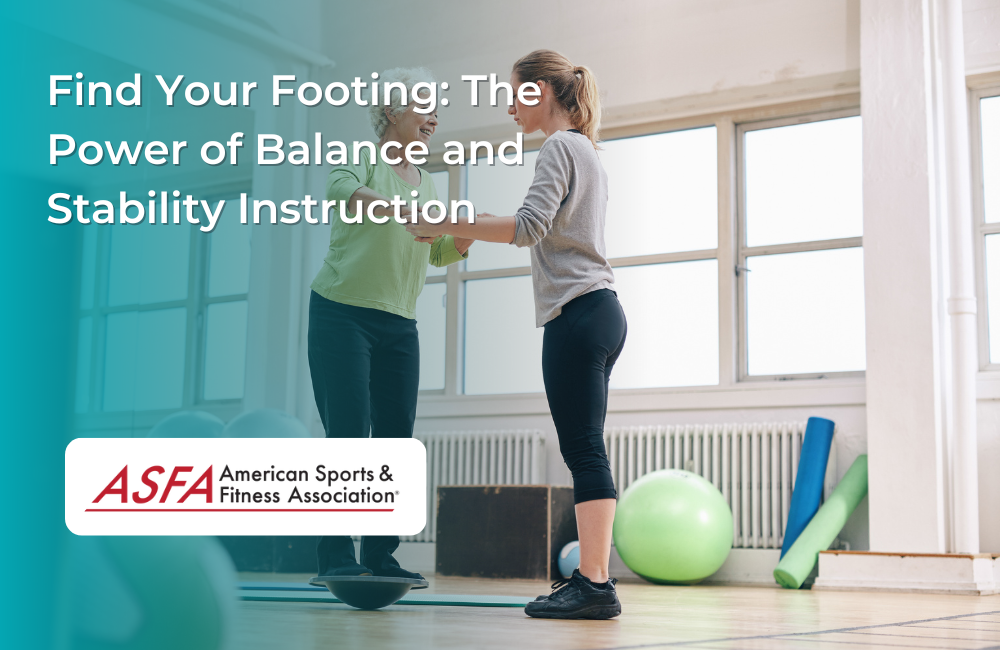With the help of a balance and stability specialist, athletes can improve their performance, reduce injury risk, and prevent future injuries. The secret to improving balance and stability is having effective training protocols. In this article, we explore five key areas that coaches must consider as they create these training protocols:
- Maximize the Training Effect;
- Corrective Exercise;
- Balance and Stability Instruction in Practice;
- Achieving Consistency with Coaches and Athletes;
- Improving Performance Outcomes for All Athletes—from Beginner to Elite
The 5 Basics of Balance and Stability Instruction
The 5 Basics of Balance and Stability Instruction
Maximize the Training Effect: Corrective exercise should be part of every athlete's training program. It helps you to achieve proper alignment, establish good movement patterns and strengthen weak muscles so that you can perform better on the field or court.
Balance and Stability Instruction in Practice: Balance and stability instruction is a great tool for coaches to use during practice sessions with their athletes because it allows them to work on specific skills without having them run laps or do traditional drills that don't directly translate into performance on game day (or court).
Achieving Consistency with Coaches and Athletes: One way we can make sure our athletes are getting consistent feedback from us when teaching them how we want them positioned during competition is by using video analysis software where coaches can mark specific areas of concern while watching videos together as well as share clips via email quickly after games/scrimmages have ended so they don't forget anything important before next practice session begins!
Maximize the Training Effect
In order to maximize the training effect, it is important that you use the right exercises. The goal of this guide is to help you identify what those exercises are so that you can achieve your goals.
- Use a progression model: Every exercise should be done with increasing intensity and difficulty over time. This ensures that your body is challenged enough without being pushed past its limits or becoming injured in the process. It also helps build strength through repetition as well as improve mobility throughout every muscle group in your body.
- Use variety: If you want to get maximum results from each workout session, it's essential that we vary our movements regularly. This way we'll never plateau on one particular movement pattern (which could happen if all we ever did were push-ups). We want our bodies to move dynamically through space - which means doing lots of different things!
Corrective Exercise
Corrective exercise is a form of exercise that focuses on improving movement patterns and reducing pain. It is not a form of physical therapy, although it can be used as part of a rehabilitation program. Corrective exercises are usually prescribed by an experienced personal trainer or physical therapist who has been trained in this specific field.
Corrective exercises are designed to correct muscle imbalances and improve your range of motion and mobility, both of which can lead to injury if left untreated. They're also useful for treating existing injuries or preventing them from reoccurring (e.g. if you have chronic knee pain). Corrective training may include stretching, strengthening, and stabilization exercises targeted at specific muscle groups involved in certain activities such as running or dancing; this helps ensure proper posture while performing these tasks without increasing the risk for further damage due to improper alignment during movement patterns like walking/running/jogging, etc..
Balance and Stability Instruction in Practice
In practice, a coach or athlete may find that it is difficult to achieve consistency with balance and stability instruction. This is because the goal of balance and stability instruction is not simply to learn how to stand on one leg or perform a squat safely; rather, your goal should be to create an environment where your clients can perform these tasks consistently at home or in their own gyms. To do this effectively, you must consider:
- Consistency within each session - How do I get my athletes moving more efficiently? How can I prepare them for the competition? These are questions that every coach asks themselves before each training session with their athletes.
- Consistency between sessions - What exercises will we do today? Do they need any corrective exercises before we begin working out together again? These questions are important because they help coaches determine what type(s) of activities might benefit from additional attention during future sessions together
Achieving Consistency with Coaches and Athletes
Achieving consistency is the key to success for coaches and athletes alike. It's not enough to just have a good idea or plan; you need to be able to follow through with it. To help you maintain your balance, here are some tips:
- Make sure your workouts are consistent every day--from week to week, month to month, and year to year. When working out with others or on your own, make sure that each workout has the same number of sets per muscle group and reps within each set (for example three sets of 10 reps). This will allow you to track progress more easily over time by comparing results from previous workouts with current ones.
Takeaway:
The takeaway is the most important part of your article. It should summarize the main points of your argument, and it should also be a call to action. The takeaway should be something that readers can remember, so you can use a quote, joke, or question if necessary (but only if it's relevant).
Conclusion
We hope that this article has provided some insight into the world of balance and stability instruction. We know that it can be confusing, but we also know how important it is to have a solid understanding of what you're doing as an athlete or coach. If you want to learn more about how we can help with all of your training needs, contact us today!





